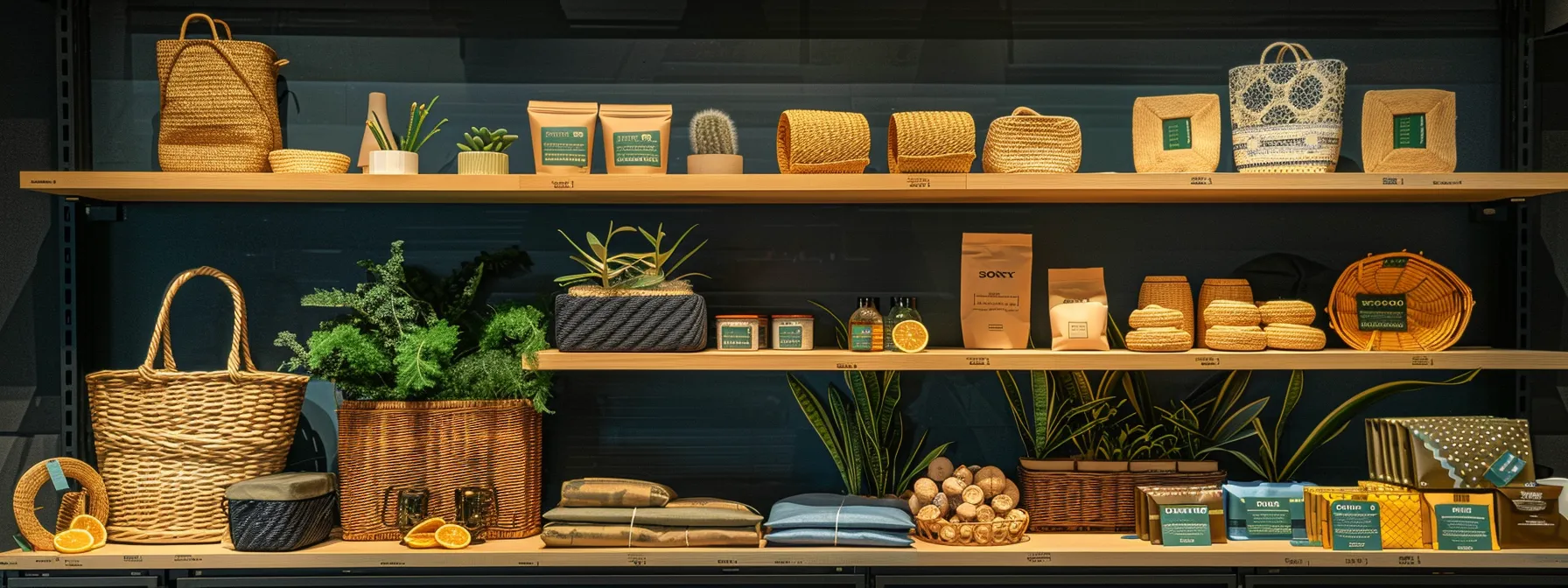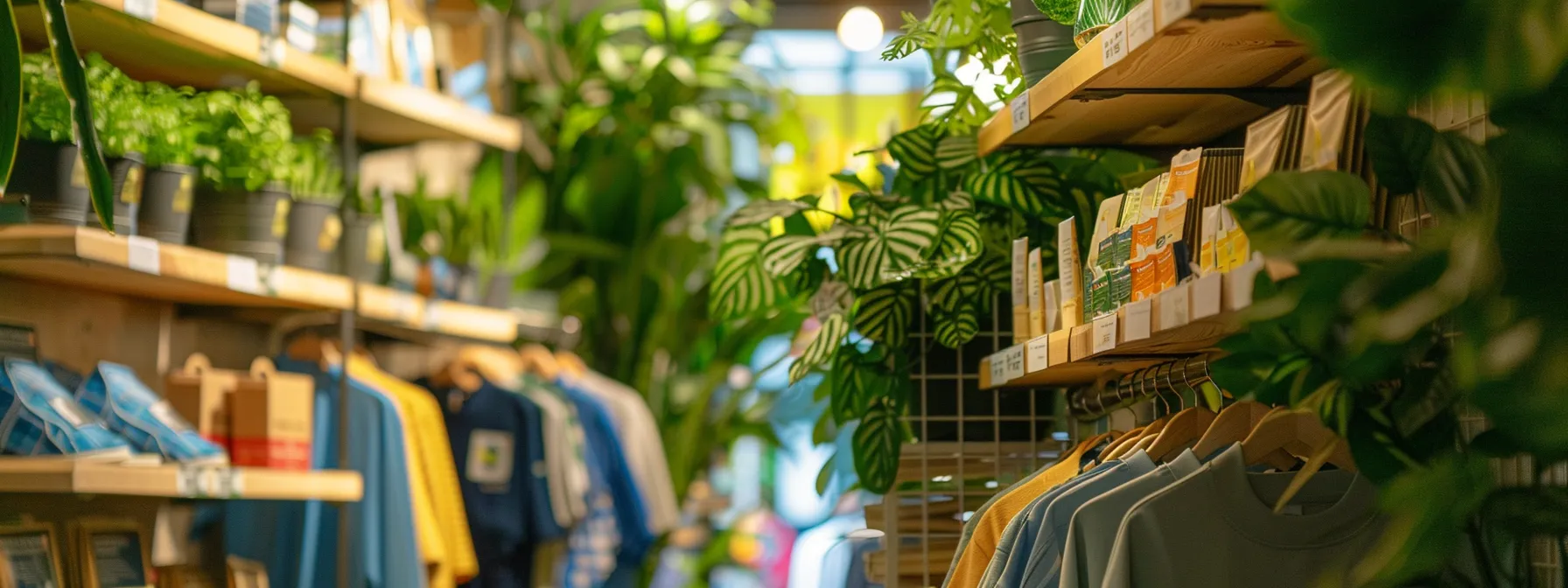Table Of Contents:
- Key Takeaways
- Understanding the Importance of Sustainable Marketing Merchandise
- Selecting Sustainable Merchandise That Aligns With Your Brand
- Innovative Green Marketing Merchandise Options
- Integrating Sustainable Merchandise Into Your Marketing Strategy
- Communicating Your Sustainability Efforts to Customers
- Real-World Examples of Brands Using Green Merchandise Successfully
Are you struggling to make your brand stand out in a crowded market? With 66% of consumers willing to pay more for sustainable products, the adoption of sustainable green marketing merchandise can significantly enhance your brand‘s appeal. In this post, I will explore the importance of selecting the right sustainable merchandise, innovative options available, and how to effectively integrate these products into your marketing strategy. By addressing common concerns about greenwashing and aligning your supply chain with sustainable practices, you can boost your brand‘s reputation and foster a positive attitude among your customers.
Key Takeaways
- sustainable marketing enhances brand reputation and attracts eco-conscious consumers
- transparency in sustainability claims builds trust and prevents greenwashing
- partnering with ethical suppliers supports quality and responsible sourcing
- storytelling about sustainability initiatives engages customers and fosters loyalty
- measuring impact helps refine strategies and align offerings with consumer values
Understanding the Importance of Sustainable Marketing Merchandise

The rise of eco-friendly consumer choices is reshaping how brands approach marketing merchandise. By connecting sustainability with brand reputation, I can enhance my business’s image while addressing the risks associated with high carbon footprints. Additionally, understanding the environmental benefits can lead to greater business success, as consumers increasingly favor brands that prioritize responsible consumption Popular promotion items for business and social influence.
The Rise of Eco-Friendly Consumer Choices
As I observe the growing trend of eco-friendly consumer choices, it’s clear that many individuals are becoming more conscious of their purchasing decisions. Consumers are increasingly opting for products that minimize plastic use and support sustainable practices. This shift not only reflects a desire for quality but also a commitment to addressing environmental issues that affect us all.
The Federal Trade Commission has recognized this change, providing guidelines that encourage brands to be transparent about their sustainability claims. By aligning my marketing merchandise with these guidelines, I can build trust with consumers who are looking for authenticity in their brand interactions. This transparency is essential in a market where consumers are more informed and skeptical about greenwashing.
Moreover, sustainable marketing merchandise can also extend to sectors like agriculture, where eco-friendly practices are becoming a priority. By incorporating sustainable materials and methods into my promotional products, I can appeal to a demographic that values environmental responsibility. This not only enhances my brand‘s reputation but also positions my business as a leader in the movement toward sustainable consumption.
Connecting Sustainability With Brand Reputation
Connecting sustainability with brand reputation is essential for any sustainable business. When I incorporate eco-friendly practices into my marketing merchandise, I not only enhance my brand‘s image but also align with consumer values. This alignment fosters trust, as customers are more likely to support brands that demonstrate a genuine commitment to sustainability.
To effectively communicate my sustainability claims, I ensure that my marketing materials adhere to the Federal Trade Commission‘s green guides. By being transparent about my policies and practices, I can avoid the pitfalls of greenwashing, which can damage my brand‘s reputation. This transparency is crucial at the point of sale, where consumers make quick decisions based on the information presented to them.
Moreover, I find that promoting sustainable marketing merchandise can differentiate my brand in a crowded marketplace. By showcasing my commitment to environmental responsibility, I attract a loyal customer base that values sustainability. This not only boosts my brand reputation but also positions my business as a leader in the movement toward responsible consumption:
- Aligning marketing merchandise with eco-friendly practices.
- Ensuring transparency in sustainability claims.
- Building trust with consumers through clear policies.
- Differentiating the brand in a competitive market.
- Attracting a loyal customer base focused on sustainability.
Environmental Benefits Translating to Business Success
Incorporating sustainable marketing merchandise into my brand strategy not only addresses climate change but also enhances customer loyalty. By offering products made from materials like bamboo, I can appeal to environmentally conscious consumers who prioritize sustainability in their purchasing decisions. This alignment with consumer values fosters a deeper connection, encouraging repeat business and long-term loyalty.
Reducing waste through eco-friendly promotional items is another way I can translate environmental benefits into business success. By choosing products that are reusable or made from recycled materials, I demonstrate my commitment to sustainability. This not only attracts customers who are concerned about their environmental impact but also positions my brand as a responsible choice in a market that increasingly demands such practices.
As I focus on sustainable marketing merchandise, I recognize that the demand for eco-friendly products is on the rise. Consumers are actively seeking brands that reflect their values, and by meeting this demand, I can differentiate my business from competitors. This strategic approach not only enhances my brand‘s reputation but also contributes to a positive impact on the environment, creating a win-win situation for both my business and the planet.
Sustainable marketing merchandise is more than a trend; it’s a commitment to the future. Now, let’s explore how to choose sustainable products that truly reflect your brand’s values.
Selecting Sustainable Merchandise That Aligns With Your Brand

When selecting sustainable merchandise, I focus on evaluating eco-friendly product options that align with my brand‘s values and mission. It’s essential to ensure that the goods and services I offer reflect a commitment to corporate social responsibility while minimizing greenhouse gas emissions. Additionally, I look for certifications that validate my sustainability claims, ensuring that my products genuinely contribute to a greener future.
This approach not only enhances my brand‘s reputation but also resonates with consumers who prioritize sustainability. In the following sections, I will delve deeper into evaluating eco-friendly options, aligning products with brand values, and identifying key certifications to look for in green merchandise.
Evaluating Eco-Friendly Product Options
When I evaluate eco-friendly product options, I prioritize materials that contribute to sustainability and environmental protection. For instance, I often choose items made from recycled or biodegradable materials, as these options help reduce waste and minimize the impact on the natural environment. This not only aligns with my brand values but also resonates with consumers who are increasingly aware of their purchasing decisions.
Research plays a crucial role in my selection process. I look for products that have been certified by reputable organizations, ensuring they meet specific sustainability standards. By doing this, I can confidently promote my merchandise as genuinely eco-friendly, which enhances my credibility and builds trust with my audience. This transparency is vital in content marketing, as consumers seek authenticity in the brands they support.
Additionally, I consider the lifecycle of the products I choose. Understanding how a product is made, used, and disposed of allows me to make informed decisions that reflect my commitment to sustainability. By selecting items that not only serve a purpose but also contribute positively to environmental protection, I can effectively boost my brand‘s image while appealing to a growing demographic of eco-conscious consumers.
Ensuring Products Reflect Brand Values and Mission
Ensuring that my products reflect my brand values and mission is crucial in promoting sustainable green marketing merchandise. I focus on sourcing items that align with my commitment to environmentalism, which includes avoiding fast fashion products that contribute to landfill waste. By selecting durable and ethically produced merchandise, I can demonstrate my dedication to sustainability and responsible consumption.
In my selection process, I prioritize products that are compostable or made from recycled materials. This not only reduces the environmental impact but also resonates with consumers who are increasingly knowledgeable about their purchasing choices. By offering items that support a circular economy, I can effectively communicate my brand‘s mission and values to my audience.
Ultimately, aligning my merchandise with my brand‘s core values fosters trust and loyalty among customers. When I showcase products that reflect my commitment to sustainability, I attract a demographic that values ethical practices. This alignment not only enhances my brand‘s reputation but also contributes to a positive impact on the environment, creating a meaningful connection with my audience:
- Source products that align with environmentalism.
- Avoid fast fashion to reduce landfill waste.
- Prioritize compostable and recycled materials.
- Communicate brand values through sustainable choices.
- Foster trust and loyalty among eco-conscious consumers.
Certifications to Look for in Green Merchandise
When selecting environmentally friendly merchandise, I prioritize certifications that validate a product‘s sustainability claims. Certifications such as the Global Organic Textile Standard (GOTS) and the Forest Stewardship Council (FSC) indicate that the materials used are sourced responsibly and produced without harmful pollutants. These certifications not only enhance my brand‘s credibility but also assure consumers that they are making a positive impact on the climate.
Another important certification to consider is the Cradle to Cradle Certified™ mark, which evaluates products based on their environmental and social performance. This certification ensures that the merchandise I choose is designed with the entire lifecycle in mind, promoting a circular economy that benefits both organisms and the environment. By offering products with this certification, I can attract eco-conscious consumers who value sustainability in their purchasing decisions.
Additionally, I look for products certified by the Energy Star program, which signifies energy efficiency and reduced greenhouse gas emissions. This certification is particularly relevant for promotional items that require energy during production or use. By incorporating Energy Star certified products into my marketing strategy, I can further align my brand with environmentally friendly practices, appealing to consumers who prioritize reducing their carbon footprint.
Choosing the right merchandise is just the beginning. Now, let’s explore some innovative green marketing options that can elevate your brand and resonate with your audience.
Innovative Green Marketing Merchandise Options

In my pursuit of effective green marketing, I focus on innovative merchandise options that resonate with eco-conscious consumers. Reusable items that reduce waste not only promote sustainability but also enhance brand visibility. Additionally, biodegradable and compostable product choices align with sustainable fashion trends, while technology-driven sustainable gifts serve as valuable resources for modern consumers. Each of these options plays a crucial role in my market segmentation strategy, ensuring I meet the diverse needs of my audience.
Reusable Items That Reduce Waste
In my experience, incorporating reusable items into my marketing strategy significantly reduces waste while enhancing brand visibility. Products like stainless steel water bottles or reusable shopping bags not only serve practical purposes but also promote sustainable behavior among consumers. By choosing these items, I can effectively communicate my commitment to environmental responsibility, which resonates with eco-conscious customers.
Additionally, I focus on the energy savings associated with reusable products. For instance, by encouraging customers to use reusable containers instead of single-use packaging, I help reduce the overall demand for new materials. This not only lowers production expenses but also aligns with a broader strategy of minimizing environmental impact, which is increasingly important to today’s consumers.
Moreover, I pay close attention to the packaging and labeling of these reusable items. Clear, informative labeling that highlights the sustainability features of my products can influence consumer behavior positively. By showcasing the benefits of using reusable merchandise, I can foster a deeper connection with my audience, ultimately driving brand loyalty and encouraging repeat purchases.
Biodegradable and Compostable Product Choices
In my experience, incorporating biodegradable and compostable products into my marketing strategy is a powerful way to promote sustainable consumption. These innovative options not only reduce waste but also resonate with customers who prioritize eco-friendly choices. By offering products that break down naturally, I can demonstrate my commitment to environmental responsibility while appealing to a growing demographic of conscious consumers.
For instance, I often choose biodegradable packaging for my promotional items, which helps minimize the environmental impact of my marketing efforts. This choice not only enhances my brand‘s image but also encourages customers to engage in reuse and responsible disposal practices. By highlighting these sustainable products in my marketing materials, I can effectively communicate my brand‘s values and attract eco-conscious customers.
Moreover, I find that promoting compostable items, such as utensils and plates made from plant-based materials, aligns perfectly with the trend toward sustainable consumption. These products provide practical solutions for events and gatherings, allowing customers to enjoy convenience without compromising their environmental values. By integrating these options into my offerings, I can foster a deeper connection with my audience and position my brand as a leader in sustainable marketing:
Technology-Driven Sustainable Gifts
In my experience, technology-driven sustainable gifts are an effective way to enhance brand visibility while promoting eco-friendly practices. These consumer products often incorporate features like solar charging or energy-efficient designs, which not only appeal to environmentally conscious customers but also align with the principles of sustainable development. By offering such innovative items, I can position my brand as a forward-thinking leader in the retail space.
One example of technology-driven sustainable gifts includes reusable tech accessories made from recycled materials. These products, such as phone cases or laptop sleeves, not only reduce waste but also resonate with consumers who prioritize sustainability in their purchasing decisions. By integrating these items into my marketing strategy, I can effectively communicate my commitment to recycling and responsible consumption, fostering a deeper connection with my audience.
Additionally, I find that incorporating smart gadgets that promote energy efficiency can significantly enhance my brand‘s appeal. For instance, offering energy-saving smart plugs or LED light bulbs as promotional gifts demonstrates my dedication to sustainable practices. This approach not only meets the growing demand for eco-friendly consumer products but also reinforces my brand‘s reputation as a responsible choice in a competitive market.
Now that we’ve explored the exciting world of green marketing merchandise, it’s time to consider how to weave these options into your overall strategy. The right approach can elevate your brand and resonate with customers who care about the planet.
Integrating Sustainable Merchandise Into Your Marketing Strategy

Incorporating sustainable merchandise into my marketing strategy involves careful planning for cost-effective green solutions that align with sustainable living. I will explore how to effectively integrate promotional items into events and campaigns, ensuring they resonate with my audience. Additionally, partnering with ethical suppliers and manufacturers is crucial for maintaining quality while supporting renewable energy initiatives. Each of these elements plays a vital role in enhancing my brand‘s reputation and appeal.
Planning for Cost-Effective Green Solutions
When planning for cost-effective green solutions, I focus on sourcing sustainable merchandise that aligns with my budget while still delivering quality. By researching suppliers who specialize in eco-friendly products, I can find options that not only meet my sustainability goals but also fit within my financial constraints. This approach allows me to maintain a commitment to environmental responsibility without compromising on the effectiveness of my marketing efforts.
In my experience, bulk purchasing of sustainable items can significantly reduce costs. By ordering larger quantities, I often benefit from discounts, which makes it easier to integrate eco-friendly products into my marketing strategy. This not only enhances my brand‘s image but also ensures that I can provide high-quality, sustainable merchandise to my customers at a competitive price.
Additionally, I prioritize partnerships with local suppliers to minimize shipping costs and reduce my carbon footprint. By collaborating with businesses in my area, I can support the local economy while also ensuring that my marketing merchandise is produced and delivered in an environmentally friendly manner. This strategy not only aligns with my sustainability goals but also strengthens my brand‘s reputation as a responsible and community-focused business.
Incorporating Merchandise Into Promotions and Events
Incorporating sustainable merchandise into my promotions and events is a strategic way to enhance brand visibility while demonstrating my commitment to environmental responsibility. I focus on selecting eco-friendly items that align with the theme of the event, ensuring they resonate with attendees. For example, using reusable tote bags or biodegradable utensils at a community event not only serves a practical purpose but also reinforces my brand‘s dedication to sustainability.
To maximize the impact of my sustainable merchandise, I integrate these items into my marketing campaigns. I often create promotional bundles that include eco-friendly products, encouraging customers to engage with my brand while promoting responsible consumption. This approach not only attracts eco-conscious consumers but also fosters a sense of community around shared values, enhancing customer loyalty.
Additionally, I pay attention to how I present these sustainable items during events. Clear messaging about the environmental benefits of the merchandise can significantly influence consumer perceptions. By highlighting the positive impact of choosing eco-friendly products, I can effectively communicate my brand‘s mission and values, creating a lasting impression on my audience:
Partnering With Ethical Suppliers and Manufacturers
Partnering with ethical suppliers and manufacturers is a crucial step in my journey toward integrating sustainable merchandise into my marketing strategy. By collaborating with companies that prioritize environmental responsibility, I can ensure that the products I offer align with my brand‘s commitment to sustainability. This partnership not only enhances my credibility but also resonates with consumers who are increasingly seeking out brands that reflect their values.
In my experience, working with ethical suppliers often leads to higher quality products that are produced with minimal environmental impact. For instance, I have found that sourcing items made from recycled materials or sustainably harvested resources not only supports my sustainability goals but also appeals to eco-conscious consumers. This alignment helps me build a loyal customer base that appreciates my dedication to responsible sourcing.
Moreover, establishing strong relationships with ethical manufacturers allows me to stay informed about the latest sustainable practices and innovations in the industry. This knowledge enables me to continuously improve my product offerings and marketing strategies. By showcasing these partnerships in my promotional materials, I can effectively communicate my brand‘s commitment to sustainability, further enhancing my reputation in a competitive market.
You have chosen your sustainable merchandise wisely. Now, it’s time to share your commitment with your customers and show them the value of your efforts.
Communicating Your Sustainability Efforts to Customers

To effectively communicate my sustainability efforts, I focus on highlighting eco-friendly initiatives in my marketing materials. Engaging customers through compelling stories of sustainability allows me to connect on a deeper level. Additionally, I prioritize transparency regarding my environmental impact and practices, ensuring that my audience understands my commitment to responsible consumption. Each of these strategies plays a vital role in enhancing my brand‘s reputation and fostering customer loyalty.
Highlighting Eco-Friendly Initiatives in Marketing Materials
In my marketing materials, I prioritize showcasing my eco-friendly initiatives to connect with consumers who value sustainability. By highlighting specific actions, such as using recycled materials in my products or implementing energy-efficient practices in my operations, I can effectively communicate my commitment to environmental responsibility. This transparency not only builds trust but also resonates with customers who are increasingly making purchasing decisions based on a brand‘s sustainability efforts.
To engage my audience further, I incorporate compelling visuals and narratives that illustrate the positive impact of my sustainable practices. For instance, sharing before-and-after images of my packaging redesign to reduce plastic waste can create a powerful story that captures attention. By presenting these initiatives in a relatable manner, I can inspire customers to support my brand while reinforcing their own values regarding responsible consumption.
Additionally, I ensure that my messaging is clear and consistent across all platforms, from social media to email campaigns. By using straightforward language and avoiding jargon, I make it easy for consumers to understand my sustainability efforts. This approach not only enhances my brand‘s credibility but also encourages customers to engage with my initiatives, fostering a community of like-minded individuals who are passionate about making a positive environmental impact.
Engaging Customers Through Stories of Sustainability
Engaging customers through stories of sustainability is a powerful way to connect with my audience and enhance my brand‘s image. By sharing real-life examples of how my sustainable practices make a difference, I can illustrate the positive impact of my eco-friendly marketing merchandise. For instance, I often highlight how switching to biodegradable packaging has significantly reduced waste in my operations, resonating with consumers who prioritize environmental responsibility.
In my marketing efforts, I focus on creating narratives that showcase the journey of my sustainable products. I share stories about the sourcing of materials, the ethical production processes, and the benefits of using eco-friendly items. This approach not only informs my customers but also fosters a sense of community around shared values, encouraging them to support my brand as a responsible choice in the marketplace.
To effectively communicate these stories, I utilize various platforms, including social media and email newsletters. By incorporating visuals and testimonials from satisfied customers, I can create a compelling narrative that highlights my commitment to sustainability. This strategy not only engages my audience but also builds trust, as consumers are more likely to support brands that demonstrate genuine efforts toward environmental stewardship:
Transparency in Environmental Impact and Practices
Transparency in environmental impact and practices is essential for building trust with my customers. I make it a priority to openly share information about the materials I use, the production processes I follow, and the steps I take to minimize my carbon footprint. By providing clear and accessible data, I can demonstrate my commitment to sustainability, which resonates with consumers who value responsible business practices.
In my marketing efforts, I highlight specific initiatives that showcase my dedication to reducing environmental harm. For example, I often share details about my partnerships with ethical suppliers and the certifications my products hold. This level of transparency not only enhances my brand‘s credibility but also encourages customers to feel confident in their purchasing decisions, knowing they are supporting a brand that prioritizes sustainability.
Moreover, I actively seek feedback from my customers regarding my sustainability practices. By engaging in open conversations and addressing any concerns they may have, I can foster a sense of community around shared values. This approach not only strengthens my relationship with my audience but also reinforces my brand‘s reputation as a leader in sustainable green marketing merchandise.
Brands are finding new ways to show their commitment to the planet. Let’s look at some real-world examples of companies that have embraced green merchandise and thrived.
Real-World Examples of Brands Using Green Merchandise Successfully

In this section, I will explore real-world examples of brands successfully using sustainable green marketing merchandise. First, I’ll present a case study that highlights how a company boosted brand loyalty through sustainability initiatives. Next, I’ll share lessons learned from industry leaders in eco-friendly marketing. Finally, I’ll discuss how to measure success by examining the impact on brand perception.
Case Study: Boosting Brand Loyalty Through Sustainability
One notable case study that illustrates the power of sustainable green marketing merchandise is that of a well-known outdoor apparel brand. By integrating eco-friendly materials into their product lines, such as recycled polyester and organic cotton, they not only reduced their environmental impact but also resonated with their target audience. This commitment to sustainability helped them build a loyal customer base that values responsible consumption, ultimately boosting their brand loyalty.
In my experience, this brand effectively communicated its sustainability initiatives through various marketing channels, including social media and email campaigns. They shared stories about their sourcing practices and the positive environmental impact of their products, which engaged consumers and fostered a sense of community. By being transparent about their efforts, they established trust with their audience, making customers feel good about their purchasing decisions.
Furthermore, the brand‘s focus on sustainable merchandise translated into increased sales and positive brand perception. Customers appreciated the quality and durability of the eco-friendly products, leading to repeat purchases and word-of-mouth referrals. This case study demonstrates that by prioritizing sustainability in marketing merchandise, businesses can not only enhance their brand image but also cultivate lasting relationships with environmentally conscious consumers.
Lessons From Industry Leaders in Eco-Friendly Marketing
One key lesson I’ve learned from industry leaders in eco-friendly marketing is the importance of authenticity. Brands that genuinely commit to sustainable practices, rather than just using them as a marketing gimmick, tend to build stronger connections with their customers. For instance, companies that transparently share their sustainability journey, including challenges and successes, foster trust and loyalty among eco-conscious consumers.
Another valuable insight is the power of storytelling in promoting sustainable green marketing merchandise. By sharing compelling narratives about how their products are made and the positive impact on the environment, brands can engage their audience on a deeper level. I’ve seen brands effectively use social media and email campaigns to highlight their eco-friendly initiatives, which not only boosts brand visibility but also encourages customers to become advocates for their products.
Finally, collaboration with other sustainable brands can amplify the impact of eco-friendly marketing efforts. I’ve observed that partnerships can lead to innovative product offerings and shared resources, enhancing the overall sustainability message. By working together, brands can reach a wider audience and create a stronger collective impact, ultimately driving more consumers toward responsible purchasing decisions:
Measuring Success: The Impact on Brand Perception
Measuring the impact of sustainable green marketing merchandise on brand perception is essential for understanding how my efforts resonate with consumers. I have observed that brands that prioritize eco-friendly practices often see a significant boost in customer trust and loyalty. This shift in perception can lead to increased sales, as consumers are more likely to support brands that align with their values regarding sustainability.
For instance, I have seen companies that effectively communicate their commitment to sustainability through transparent marketing strategies. By sharing their eco-friendly initiatives and the positive environmental impact of their products, these brands enhance their reputation in the eyes of consumers. This approach not only attracts eco-conscious customers but also fosters a community of advocates who are eager to promote the brand.
Ultimately, the success of sustainable green marketing merchandise can be measured through various metrics, including customer feedback and brand loyalty. I find that tracking these indicators helps me refine my marketing strategies and better align my offerings with consumer expectations. By focusing on sustainability, I can create a positive brand perception that resonates with my target audience:
- Increased customer trust and loyalty.
- Effective communication of eco-friendly initiatives.
- Positive brand reputation and community advocacy.
- Measurable metrics for tracking success.



